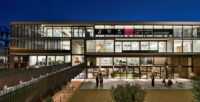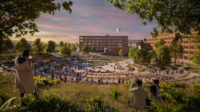Jerusalem, Israel
Passing through the Dung Gate on the south end of Jerusalem’s Old City walls, visitors walk down a Herodian street built 2,000 years ago and get a breathtaking view of an archaeological park overlooking the Temple Mount, the site of the Second Temple (destroyed in 70 A.D.) where the Dome of the Rock and Al-Aqsa mosques now stand. The park sits above and around the ruins of four Umayyad palaces built by the city’s Islamic rulers in the 7th and 8th centuries and serves as the home of the Davidson Center, a museum designed by Kimmel Eshkolot Architects that tells the story of the site’s transformations throughout history.
Jerusalem’s role as a holy place for three major religions has made it a battlefield and object of conquest. The city has been built, destroyed, and rebuilt numerous times, and the archaeological artifacts displayed in the Davidson Center bear silent witness to these events. (The museum is named for its main benefactor, Michigan industrialist William Davidson, who until his death four months ago owned Guardian Industries, one of the largest manufacturers of float glass in the world.) In Jerusalem, relics from the Second Temple era (516 B.C.–70 A.D.) reveal the city’s glory days, when King Herod transformed the Temple Mount and its surrounding areas into a lively, social center. Excavations from the Byzantine period (330–638) attest to the early Christian character of the city, then give way to Umayyad rule, from 638 to 750, when the Arab Caliphate constructed a monumental government center at the foot of the Dome of the Rock and Al-Aqsa mosques.
Building on an archaeological site with so much historical, political, and cultural significance posed a tremendous challenge. “How often is an architect granted the opportunity to work on a site considered one of the holiest places in the world?” asks architect Etan Kimmel. Meeting the challenge occupied Kimmel and his partner Michal Eshkolot for more than a decade, from their competition-winning design in 1996, when both architects were in their 30s, to the opening of the museum’s first phase in 2001 and its completion in 2007. Since winning the Davidson competition, the Tel Aviv–based firm has grown to become one of the most important in Israel today.
Kimmel Eshkolot’s strategy for the 10,800-square-foot Davidson was to make much of it transparent and keep its height as low as possible, so it wouldn’t rival the presence of the archaeological park or the Old City walls. As built, it rests mostly underground, with its roof level with the ancient palace floors and integrated with the park’s walkways and landscaping. “The key to the design lay in setting up a fine balance between the complete submergence of the structure underground and the marking of new traces on the surface—hints of the subterranean levels below,” write the architects in a book on the project.
Kimmel and Eshkolot designed the building as a journey that starts at the entrance level of the Umayyad palaces, then descends to the old buildings’ cellars and foundations. But instead of creating a hermetic experience for visitors as they move three levels below the roof plaza, the architects connected the building to the outdoors and the rest of the ancient city with large glass walls and a “periscope” topped by an elliptical glass lantern. From the outside, the lantern announces the presence of a modern structure on the historic site; from inside, it brings daylight below and offers a view of the Al-Aqsa Mosque.
While connecting with the outdoors and integrating itself with its setting, the new building is set apart in terms of materials and architectural expression. Butt-glazed curtain walls, for example, envelop the thick stone walls of the old palaces, and glass-and-steel walkways cross from one side of the museum to another. “We tried to emphasize the beauty of these juxtapositions of old and new,” says Kimmel.
Kimmel Eshkolot worked with designer Dorit Harel to create the museum’s interior, using a series of wood-floored ramps to take visitors down 26 feet to the Hall of Arches in the ancient cellars. The strategy was to initiate a cross-generational dialogue between old and new materials, as well as ancient and modern sensibilities. In addition to its role as a museum, the Davidson serves as a center for historical research and learning.
Kimmel says that in a place “where each epoch had eradicated the marks of its precursors, we were looking for the possibility of reconciliation.” As it takes us through layers of time, the Davidson Center offers the hope that understanding brings acceptance, if not reconciliation.















Post a comment to this article
Report Abusive Comment